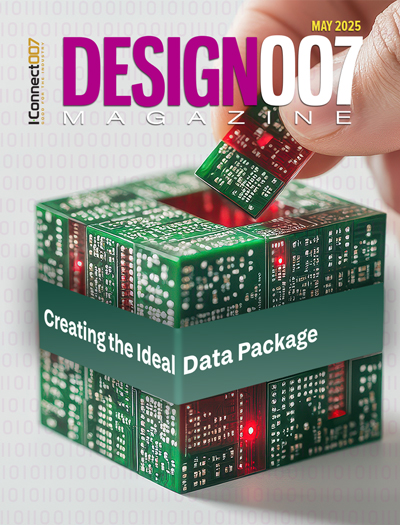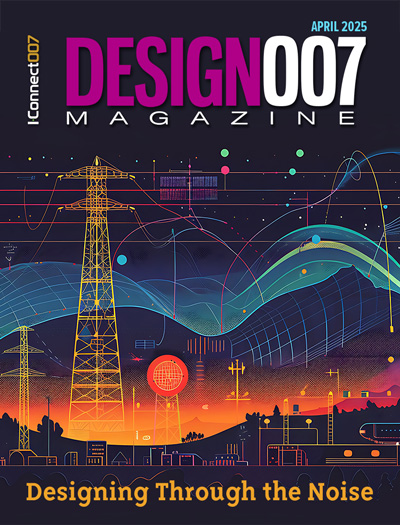-

- News
- Books
Featured Books
- design007 Magazine
Latest Issues
Current Issue
Creating the Ideal Data Package
Why is it so difficult to create the ideal data package? Many of these simple errors can be alleviated by paying attention to detail—and knowing what issues to look out for. So, this month, our experts weigh in on the best practices for creating the ideal design data package for your design.

Designing Through the Noise
Our experts discuss the constantly evolving world of RF design, including the many tradeoffs, material considerations, and design tips and techniques that designers and design engineers need to know to succeed in this high-frequency realm.

Learning to Speak ‘Fab’
Our expert contributors clear up many of the miscommunication problems between PCB designers and their fab and assembly stakeholders. As you will see, a little extra planning early in the design cycle can go a long way toward maintaining open lines of communication with the fab and assembly folks.
- Articles
- Columns
Search Console
- Links
- Media kit
||| MENU - design007 Magazine
Mentor’s Cristian Filip Discusses His Award-winning DesignCon Paper
March 21, 2019 | Andy Shaughnessy, Design007 MagazineEstimated reading time: 4 minutes
During DesignCon, I met with Cristian Filip, a senior product architect with Mentor, a Siemens business. Cristian had just received word that his paper had won a DesignCon Best Paper award—his second such award in three years. I asked Cristian to discuss his paper and how this technology can help improve manufacturing yields at high volumes.
Andy Shaughnessy: Congratulations, Cristian. You’ve written a paper that just won a DesignCon Best Paper Award. Can you tell us about yourself and the paper?
Cristian Filip: Sure. I joined Mentor in 2014. I work in the product architecture group and am involved mostly with analysis solutions. Over the last few years, I’ve co-authored about six DesignCon papers—two of them winning the Best Paper Award. One paper won in 2016 jointly with Vladimir Zdorov—one of our developers. In 2018, it was a collaboration between Hamburg University, Cisco, and Mentor.
Both of those papers that won the Best Paper Award centered around high-speed serial links, running at 28 gigabits per second. And they used channel operating margins as a figure of merit for estimating channels performance. In 2017, I had another DesignCon paper on the same area of interest, and we showed how to optimize channels while accounting for manufacturing reliability. At that time, we used design of experiments (DOE) as a method for optimization along with artificial neural networks. As a next step in the paper from 2018, we explored some improvements to the method. This time, we introduced the polynomial chaos expansion with the stochastic testing method to improve our way to optimize those links.
In this paper, "Efficient Sensitivity-Aware Assessment of High-Speed Links Using PCE and Implications for COM," we basically compared three different methods. One was based on Monte Carlo sampling, the second on DOE, using the response surface method, and the third on PCE. We showed that this new method not only reduces the number of required simulations from thousands to about 50 but also the simulation run time.
There is an additional benefit to this method because it provides better insight into what can affect the performance of the channels. This new method based on the polynomial chaos expansion with stochastic testing has the advantage of reducing the number of experiments or simulations required for channel modeling and channel optimization. It also provides additional information about the performance of various components of the channels, which are very useful in the debugging process and improving the overall performance of the channel.
Shaughnessy: How does this all work?
Filip: We took an example to show how we can apply this method based on a 100GBASE-KP4 for a channel, which is basically a backplane and two different blank cards, and we showed how various routing parameters, material parameters, and cheap I/O characteristics affect the performance of the channel. We also showed how we could optimize the link by using the proposed method.
Further, we compared the results from channel operating margin against the traditional diagrams based on eye height and eye width opening and showed that they actually correlate very well. As a basis for this new method, we started by using an open-source, publicly available library, and we made some improvements to that method. This method can be applied by anyone; it’s not related to specific tools or flow, so it’s very flexible and proved to be very efficient in our experience.
Shaughnessy: So, you’ve optimized a way for people to deal with high-speed links?
Filip: Correct, especially in high-volume manufacturing where we define the failures per million. We’re always looking at minimizing the number of failures per million. If you’re going to build a million units, you need to figure out how many will probably fail in high volume and minimize that so you can improve the yield.
Shaughnessy: And the variability seems to be a big thing too.
Filip: Yes, it is. The good thing is we typically know the distribution for the various manufacturing processes. In general, they have either Gaussian or uniform distribution, and we can apply the distribution to predict the performance of the channels. We create a model that allows us to apply a Monte Carlo type of analysis to further estimate that performance of the channel in high volume statistically.
Shaughnessy: Cool. That sounds like a good paper. Is there anything else you want to add?
Filip: I want to give a special thanks for our collaborators from Hamburg University and Cisco. It was a great experience working together with seven people from three different organizations spread across the globe.
Shaughnessy: Being that this is your second award since 2016, you seem to know what you’re talking about.
Filip: I hope so. I also want to thank Mentor for providing the opportunity to participate in this type of competition. DesignCon a great conference where so many talented people come together and exchange lots of interesting technical experiences.
Shaughnessy: Thanks so much, Cristian.
Filip: Thank you, Andy.
Suggested Items
I-Connect007 Editor’s Choice: Five Must-Reads for the Week
05/09/2025 | Andy Shaughnessy, Design007 MagazineTrade show season is wrapping up as we head into summer. Where has the time gone? I hope you all get the chance to take a vacation this year, because I know you’ve earned one. Speaking of which, when was my last vacay? If I can’t remember, it’s probably time for one. It’s been a busy week in electronics, with fallout from the back-and-forth on tariffs taking up most of the oxygen in the room. We have quite an assortment of articles and columns for you in this installment of Must-Reads. See you next time.
Kaynes Technology Acquires Canada-Based August Electronics
05/09/2025 | PRNewswireAugust Electronics Inc. is pleased to announce that it has entered into a definitive agreement to be acquired by Kaynes Canada Limited, a wholly owned step-down subsidiary of Kaynes Technology India Limited, a leading Electronics System Design & Manufacturing (ESDM) company. The transaction is expected to close by the end of May 2025, subject to customary regulatory approvals and closing conditions.
Localized Automation Becomes a Tariff Storm Safe Haven, but U.S. Smart Factory Build-Out Costs Far Exceed China’s
05/09/2025 | TrendForceTrendForce’s latest “Human-Machine Technology Report” points out that although the 90-day delay on the U.S. reciprocal tariffs announced by the Trump administration in early April 2025 offers temporary relief, it has already triggered lasting shifts in global manufacturing and supply chain strategies.
Primech AI Plans Production of 300 HYTRON Robots through its China Manufacturing Expansion
05/09/2025 | Globe NewswirePrimech AI Pte. Ltd., a subsidiary of Primech Holdings Limited announced a significant expansion of its manufacturing capabilities through a strategic manufacturing partnership in Guangdong Province, China.
Ultrahuman Expands its American Factory’s Manufacturing Capacity
05/09/2025 | GlobeNewswireUltrahuman, a pioneer in health optimization technology, has announced that it’s ramping up its capacity of the Ring AIR. Ultrahuman’s manufacturing facility (UltraFactory) in partnership with SVtronics, a US-based electronics manufacturing business, has been operational in Plano, Texas, since November 2024.


